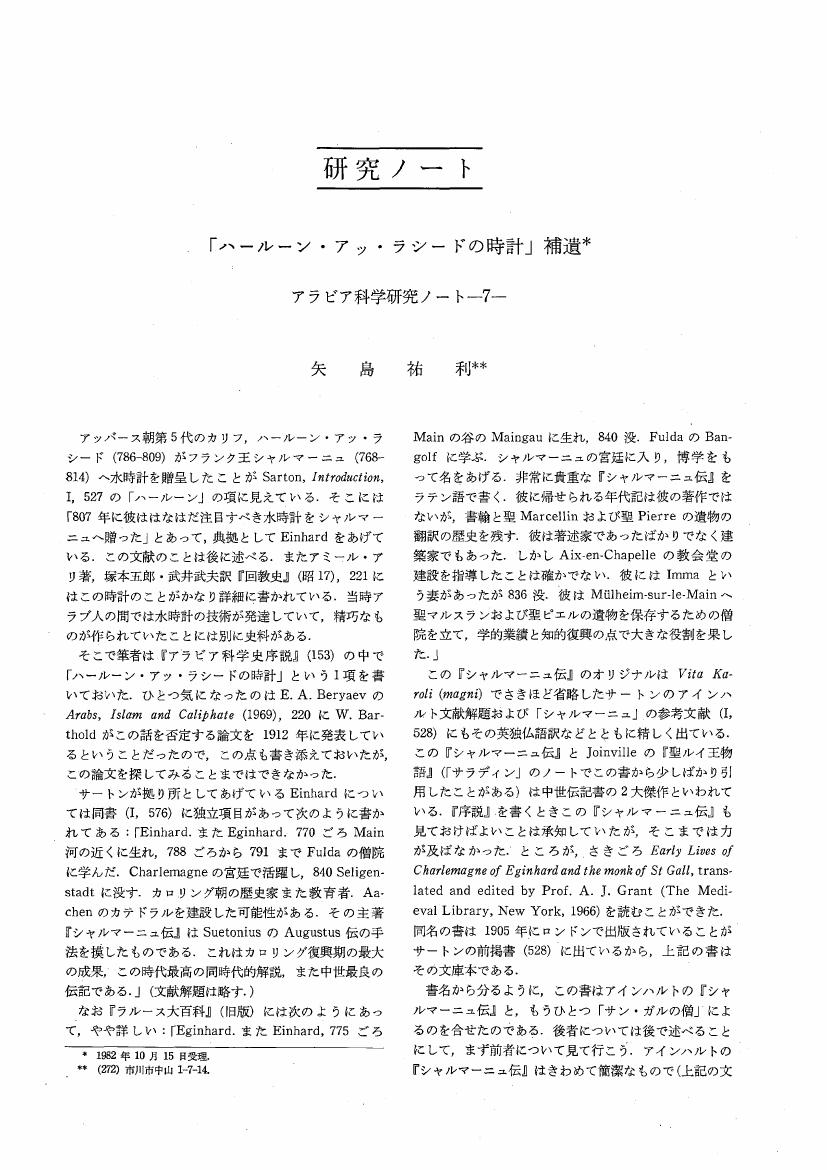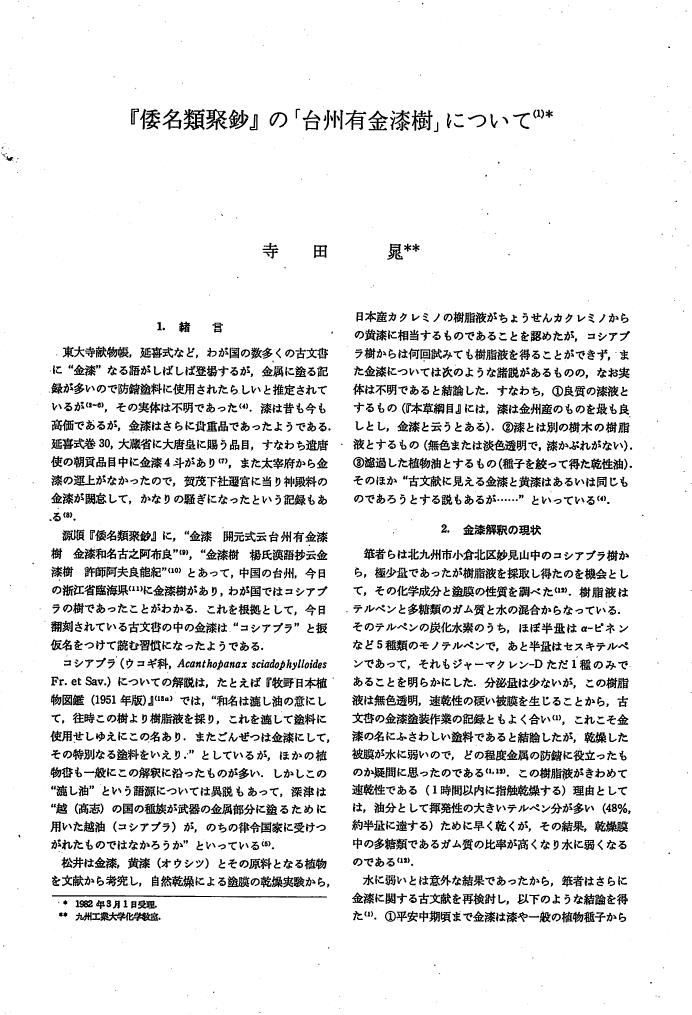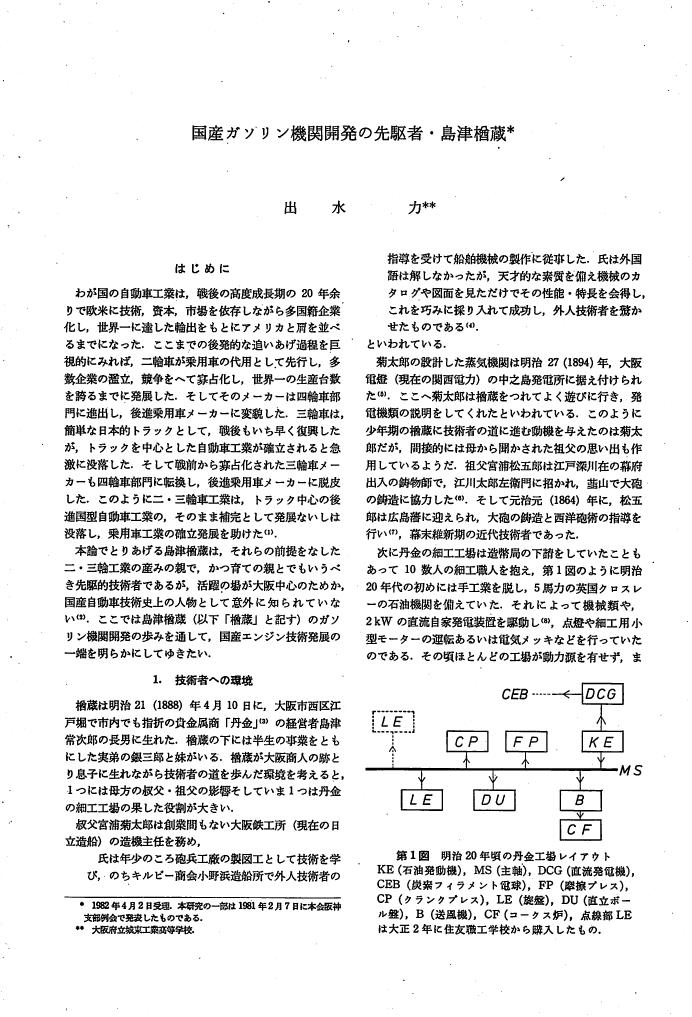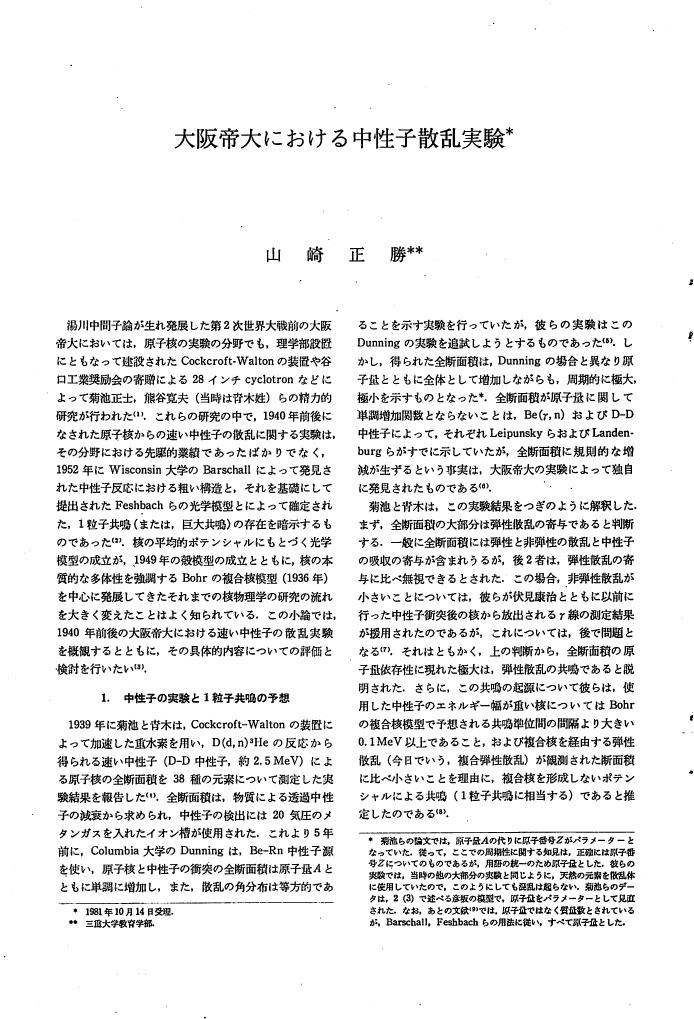1 0 0 0 OA 赤外帯スペクトルの起源に関する研究の歴史,1880~1920(Ⅱ)(1912~1920)
- 著者
- 藤崎 千代子
- 出版者
- 日本科学史学会
- 雑誌
- 科学史研究 (ISSN:21887535)
- 巻号頁・発行日
- vol.22, no.146, pp.73-85, 1983 (Released:2021-09-29)
I have dealt with the development of the understanding of the origin of the infrared band in the molecular spectrum during the period between 1880 and 1920. Deslandres' law (1886 and 1887) and P.Drude's extended study of dispersion theory,(1904) prepared the first step in understanding the origin of the infrared band spectrum. The second step was closely related to the quantum theories of specific heat of Einstein's (1907) and Nernst's (1911). Einstein's theory implicitly taught that the near infrared band was attributed to atomic vibration. On the other hand, Nernst suggested that molecular rotation energy had relation to specific heat of gases, and that its energy was quantized. In their theories, the infrared band was located as an indicator to prove the quantum theory of specific heat. In the first Solvay Conference(1911),the question about whether the quantization of rotational energy was possible or impossible, was discuussed. In 1911 and 1912, N. Bjerrum who was backed by those researches, attributed the infrared bands to atomic vibration, vibration-rotation and molecular rotation, and related the wavelengths of spectral lines of every band with the energy of every motion, by the aids of the quantum condition of Planck or Rayleigh's theory of 1892. He succeeded to shift the position of the infrared band to the position as the indicator of the molecular structure. Ehrenfest in 1913 revised Bjerrum's theory of rotational spectrum; and then by the aid of his adiabatic hypothesis, he could formulate rotational energy in the stationary state of the quantum number m. The formulation of the rotational energy contributed to the development of the later researches about rotational spectrum. The third step was prepared by the new theories of Bohr's and Sommerfeld's; the new quantum condition, the frequency condition, and the selection rule Schwarzschild in 1916 formed the theory of rotational spectrum, by the aids of th frequency condition and the quantum condition of Sommerfeld. He used Deslandres' law as the guide to prove the validity of his theory of rotational spectrum Younger theorists such as Heurlinger, Lenz and Kratzer formed theories to interprete the occurrence of vibration-rotation, or rotation bands, by the aids of two conditions and a rule (1919 and 1920). They contributed to forming the theoretical model of diatomic molecule The former could determine the quantum number of rotational spectnim, by the aid of the selection rule. Around the same time, Imes found for the first time the fine structure of the vibration-rotation band of hydrogen chloride by means of the infrared spectroscope equipping the diffraction grating (1919 and 1920) His finding proved that Bjerrum's theory of double and was incomplete. Kratzer attempted to form a theory which could interprete the fine structure, by the aids of those conditions and a rule. He contributed to the physical interpretation of "missing", the determination of the distance between nuclei of diatomic molecule, and the confirmation of the attribution of the far infrared band to molecular rotation.
1 0 0 0 OA 初期ギリシアの石工用具について ―鉄製用具導入の観点から―
- 著者
- 豊田 和二
- 出版者
- 日本科学史学会
- 雑誌
- 科学史研究 (ISSN:21887535)
- 巻号頁・発行日
- vol.22, no.146, pp.86-98, 1983 (Released:2021-09-29)
Iron metallurgy was widely understood in the Eastern Mediterranean only after 1000 B. c., and objects manufactured from iron appeared on a large scale from about 800 B C One might imagine that the Iron Age in Greece began about 1000 B. c., but recently A.M. Snodgrass has published his opinion that archaeological evidence has confirmed a reaction in favour of bronze, indicating that the introduction of iron caused no radical change in the politics or economy of the period In short, we must relinquish the view of a revolutionary change in Greek society caused by iron products in favour of one of gradual change. The introduction of iron and its general use for masons1 tools meant that they could achieve more work for less labour, time and cost, because of the difficulty of working the hard material with the earlier tools. This permitted the stonemasons of the Late Archaic Age to achieve the great age of temple building in the 6th century B. C. The tools which they used were the pick or pickhammer, point, flat-edged chisel, curved chisel, drove, claw or toothed chisel, drill, rasp and abrasives. The most important among them was the claw chisel that had a cutting edge serrated like saw teeth, and that has been acknowledged as a Greek invention, especially on the mainland. Its marks left on stone date from the second quarter of the 6th century B. C., and its use would probably have spread throughout the Greek world by about 550 B. C. The invention of the claw enabled masons to save time and labour, as the four-toothed tool could accomplish four times as much at a blow as one with singlepoint. These days We have been able to establish that Ionians brought from Greece to Iran the new techniques of using the claw, drill and so on. The most memorable of them was Chersiphron, an architect working on the Artemis temple at Ephesus, who devised a new instrument like enormous garden rollers for transporting great columns, which was probably employed at Persepolis. In conclusion, the technology of Greco-Lydian masonry had come into being by the late 7th century B. C., and spread to Persia with the beginning of the Achaemenian style, following the conquest of the west coast of Asia Minor by King Cyrus, and this stone-working sphere of the Eastern Mediterranean formed by that event, which brought Ionian craftsmen their access to Persia, continued till the early 5th century B. C The reason why Greek craftsmen could attain such wide influence was the rationalisation of time and labour ― to be more specific, the improvement of stonemasons' tools enabled them to process hard stone rapidly and efficiently, in circumstances in which the polis society, the tiny Greek community, could never expect great manpower or wealth like the big powers in the Near East.
- 著者
- 藤崎 千代子
- 出版者
- 日本科学史学会
- 雑誌
- 科学史研究 (ISSN:21887535)
- 巻号頁・発行日
- vol.22, no.145, pp.1-9, 1983 (Released:2021-10-06)
1 0 0 0 OA ‘X の発見’と実験・技術・社会(Ⅲ) ―科学的発見における偶然と必然―
- 著者
- 宮下 晋吉
- 出版者
- 日本科学史学会
- 雑誌
- 科学史研究 (ISSN:21887535)
- 巻号頁・発行日
- vol.22, no.145, pp.10-20, 1983 (Released:2021-10-06)
1 0 0 0 OA 『晋書』の中の天文史料(A. D. 221~420) ―その天文年代学的な検証―
- 著者
- 斉藤 国治
- 出版者
- 日本科学史学会
- 雑誌
- 科学史研究 (ISSN:21887535)
- 巻号頁・発行日
- vol.22, no.145, pp.21-34, 1983 (Released:2021-10-06)
The Chin Shu or Official History of the Chin Dynasty,130 volumes in total, was finished by Fang Hsüan-ling et al.in A.D.635.Astronomical records are included in its astronomical chapters. The data cover the periods from A.D.221 to A.D.420, including the times of the Three Kingdoms, the Former and Later Chin Dynasties. Among the whole records, the solar eclipses, the moon's occultations of the planets and the trespassings of the planets with one another are examined numerically by the method of astronomical chronology. The following conclusions are obtained. (1) Among 82 solar eclipses; 49 are proved to have been visible as eclipsed either at Loyang (capital of both the Wei and the Former Chin Dynasties) or at Nanking (capital of the Later Chin Dynasty). Visibility of the recorded eclipses is 49/82 = 60 percents. (2) Among 52 records of the moon's trespassings against at the planets,19 occultations and 25 trespassings are identified. So identification rate of the records is 44/54 = 81 percents. (3) Among 46 records of close encounters of the planets with one another, 36 are proved to be reasonable. So identification rate of the data is 36/46 = 72 percents. (4) The remaining percentages of the above records are classified as questionable because of their impossibility of identification. However, some of them turn reasonable if we try a tiny revision, for instance, change the date or the planet's name in the records. This proves to be a result of copying errors. In the case of solar eclipses, ancient technique of eclipse prediction may be another cause of poor coincidence.
1 0 0 0 OA 「細胞説」に関するSchwannの3篇の予報についで
- 著者
- 檜木田 辰彦
- 出版者
- 日本科学史学会
- 雑誌
- 科学史研究 (ISSN:21887535)
- 巻号頁・発行日
- vol.22, no.145, pp.35-43, 1983 (Released:2021-10-06)
In 1838, the previous year of the publication of his famous book Mikroskopische Untersuchungen, T.Schwann published three preliminary articles in Froriep's Notizen. They are, 1) "Ueber die Analogie in der Structur und dem Wachsthume der Thiere und Pflanzen" 2) "Fortsetzung der Untersuchungen über die Uebereinstimmung in der Structur der Thiere und Pflanzenn" 3) "Nachtrag zu den Untersuchungen über die Uebereinstimmung in der Structur der Thiere und Pflanzen". Moreover, they preceded the publication of Schleiden's "Beitrage zur Phytogenesis." These three articles, however, have not been given but scant attention in histories of biology or cytology. According to the "Cell Theory" of today, a cell is considered as the fundamental unit of all living organism, and the properties of a living organism are seen as the sum of the properties of its component cells. But it should be noted that Schwann, who first used the term "Cell Theory," used it to indicate a so-called Schleiden & Schwann's "Cell Formation Theory," which was to be denied later. The object of this article is to introduce the contents of Schwann's three articles critically, to point out that these articles include not only the "Cell Formation Theory," but also the very essence of the "Cell Theory" of today, therefore, to conclude the description, often seen in many histories of biology, that the "Cell Theory" was advocated by Schleiden (1838) and Schwann (1839) is not correct, and it should with greater propriety be described that the "Cell Theory" of today was advocated.by both Schwann and Schleiden in 1838.
1 0 0 0 OA 「ハールーン•アッ•ラシードの時計」補遺 アラビア科学研究ノート ―7―
- 著者
- 矢島 祐利
- 出版者
- 日本科学史学会
- 雑誌
- 科学史研究 (ISSN:21887535)
- 巻号頁・発行日
- vol.22, no.145, pp.44-46, 1983 (Released:2021-10-06)
1 0 0 0 OA 科学史におけるJohn Daltonの役割-方法論的考察-
- 著者
- 井山 弘幸
- 出版者
- 日本科学史学会
- 雑誌
- 科学史研究 (ISSN:21887535)
- 巻号頁・発行日
- vol.21, no.143, pp.129-141, 1982 (Released:2021-04-08)
1 0 0 0 OA 江戸時代の円周率の値-江戸時代のがk門と通俗書の間-
- 著者
- 板倉 聖宣 中村 邦光
- 出版者
- 日本科学史学会
- 雑誌
- 科学史研究 (ISSN:21887535)
- 巻号頁・発行日
- vol.21, no.143, pp.142-152, 1982 (Released:2021-04-08)
- 著者
- 谷本 勉
- 出版者
- 日本科学史学会
- 雑誌
- 科学史研究 (ISSN:21887535)
- 巻号頁・発行日
- vol.21, no.143, pp.153-161, 1982 (Released:2021-04-08)
1 0 0 0 OA ’X線の発見’と実験・技術・社会(Ⅰ)-T.Kuhnらの科学的発見論の検討-
- 著者
- 宮下 晋吉
- 出版者
- 日本科学史学会
- 雑誌
- 科学史研究 (ISSN:21887535)
- 巻号頁・発行日
- vol.21, no.143, pp.162-175, 1982 (Released:2021-04-08)
1 0 0 0 OA 火浣布再説
- 著者
- 城福 勇
- 出版者
- 日本科学史学会
- 雑誌
- 科学史研究 (ISSN:21887535)
- 巻号頁・発行日
- vol.21, no.144, pp.193-200, 1982 (Released:2021-04-08)
- 著者
- 宮下 晋吉
- 出版者
- 日本科学史学会
- 雑誌
- 科学史研究 (ISSN:21887535)
- 巻号頁・発行日
- vol.21, no.144, pp.201-209, 1982 (Released:2021-04-08)
1 0 0 0 OA 『倭名類聚鈔』の「台州有金漆樹」について
- 著者
- 寺田 晃
- 出版者
- 日本科学史学会
- 雑誌
- 科学史研究 (ISSN:21887535)
- 巻号頁・発行日
- vol.21, no.142, pp.65-69, 1982 (Released:2021-05-13)
- 著者
- 斉藤 国治
- 出版者
- 日本科学史学会
- 雑誌
- 科学史研究 (ISSN:21887535)
- 巻号頁・発行日
- vol.21, no.142, pp.70-80, 1982 (Released:2021-05-13)
1 0 0 0 OA 国産ガソリン機関開発の先駆者・島津楢蔵
- 著者
- 出水 力
- 出版者
- 日本科学史学会
- 雑誌
- 科学史研究 (ISSN:21887535)
- 巻号頁・発行日
- vol.21, no.142, pp.98-106, 1982 (Released:2021-05-13)
1 0 0 0 OA ドイツ博物館所蔵 "Libri rari" について -ドイツ技術史研究抄-
- 著者
- 種田 明
- 出版者
- 日本科学史学会
- 雑誌
- 科学史研究 (ISSN:21887535)
- 巻号頁・発行日
- vol.21, no.142, pp.107-118, 1982 (Released:2021-05-13)
1 0 0 0 OA Helmholtzの電気化学研究と"自由エネルギー"概念
- 著者
- 山口 宙平
- 出版者
- 日本科学史学会
- 雑誌
- 科学史研究 (ISSN:21887535)
- 巻号頁・発行日
- vol.21, no.141, pp.1-9, 1982 (Released:2021-05-13)
1 0 0 0 OA 大阪帝大における中性子散乱実験
- 著者
- 山崎 正勝
- 出版者
- 日本科学史学会
- 雑誌
- 科学史研究 (ISSN:21887535)
- 巻号頁・発行日
- vol.21, no.141, pp.10-15, 1982 (Released:2021-05-13)
- 著者
- 斉藤 国治
- 出版者
- 日本科学史学会
- 雑誌
- 科学史研究 (ISSN:21887535)
- 巻号頁・発行日
- vol.21, no.141, pp.27-36, 1982 (Released:2021-05-13)















